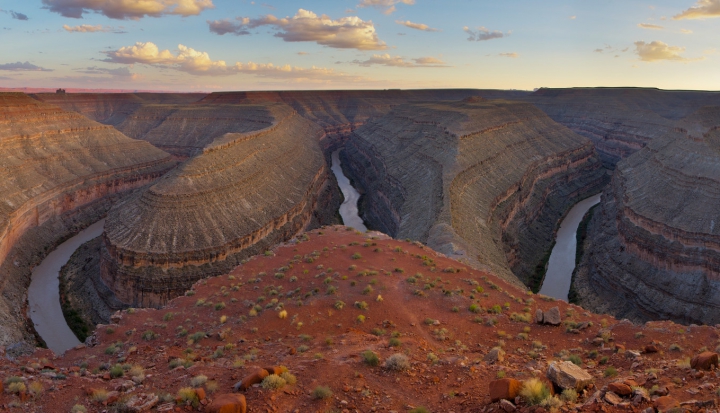Every summer, my family and I spend a couple of weeks driving across the country to visit destinations we have never been to before. Last July, our annual road trip included three of Utah’s five beautiful national parks—Arches, Canyonlands, and Zion.
The southern half of Utah is a remarkable work of art, and no two national parks are alike. Even though driving across Utah to visit the three national parks took up the bulk of our trip, I wanted to see everything at once.
Several national monuments lie between the five parks, including Bears Ears National Monument, the first national monument formed primarily through a coalition of five Native American tribes that have ancestral ties to the region. The monument is named after a pair of buttes that resemble bear ears sticking out from the horizon. Then-President Barack Obama established the 1,351,849-acre monument on Dec. 28, 2016.
Less than a year later, on December 4, 2017, President Donald Trump reduced the monument’s size by about 85 percent as an end to “another egregious abuse of federal power” and to “give [power] back to the states and to the people where it belongs.” That same day, Trump also reduced the size of south central Utah’s Grand Staircase-Escalante National Monument by almost half. The move has so far resulted in five lawsuits against the Trump administration by Native American and conservation groups.
The fight to protect these lands won’t end any time soon, and not just because of environmental concerns. Bears Ears, in particular, is sacred to the five tribes connected to the land—the Hopi, the Navajo Nation, the Ute Mountain Ute, the Pueblo of Zuni, and the Ute Indian Tribe of the Uintah and Ouray Reservation. The Bears Ears Commission of Tribes’ request that the Trump administration work with the delegation made last March was ultimately ignored.
We need to support the Native American people’s fight to protect what is sacred to them.
Christianity has a shameful history of its treatment of Native Americans going back as early as the 15th century, when European settlers used a series of papal bulls as basis to kill indigenous people and colonize their land.
“These were the documents that Christopher Columbus and others used to justify their actions,” said Shantha Ready Alonso, executive director of Creation Justice Ministries, told U.S. Catholic in an interview. “There is much work to do to heal after the theft and genocide in our country’s founding.” Creation Justice Ministries is a Christian conservation organization that works with 38 national faith bodies to promote environmental justice policies.
In the same interview, Alonso mentioned that the Navajo people used to hide in Bears Ears’ canyons to avoid being found by settlers who killed or forced them out of their homeland in what is now knows as the Long Walk to Bosque Redondo. The Navajo shared their stories of hiding in Bears Ears to avoid capture through oral tradition.
“We see this as an important role of the church: to step up and tell these stories,” Alonso said. “These are painful stories to hear, but if we’re ever going to move toward healing, we have to do truth-telling first.”
As we have seen through the international attention the Dakota Access Pipeline protests at the Standing Rock Indian Reservation between 2016 and 2017 received, Native Americans are still struggling to protect what is rightfully theirs. We are living on indigenous land, and although we cannot turn back time and prevent years of pain and suffering, we can stand up against injustice by addressing Native Americans’ current needs. Listening and researching the land you live on are a step in the right direction. Atonement over denial is always the correct answer.
Six months ago, the Jesuits returned 525 acres of land in North Dakota to the Rosebud Sioux. The Jesuits acquired the land from the U.S. government in the 1880s.
“It’s the symbolism of returning,” said Harold Compton, deputy executive director of the Rosebud Sioux’s land management corporation, Tribal Land Enterprises, in an interview with Catholic News Service.
“We don’t just do this for the tribes, or in solidarity with them; it’s important to our own healing as well,” Alonso said. “It’s necessary for us to have [Bears Ears] monument as a place where we can examine, confess, and repent our own history.”
Even though Bears Ears and Grand Staircase-Escalante aren’t historically significant to Catholicism, we must remember that all land is sacred and should be well taken care of because God created the Earth and everything in it. Romans 1:19–20 tells us:
For what can be known about God is plain to them, because God has shown it to them. Ever since the creation of the world his eternal power and divine nature, invisible though they are, have been understood and seen through the things he has made.
We must also acknowledge and respect the fact that the land encompassing Bears Ears and Grand Staircase-Escalante were sacred to indigenous Americans long before they were introduced to Christianity.
I’m a first-generation American, a daughter of two immigrants who moved to the United States due to conflicts in their homelands. Although my own ancestors did not commit any sins again Native Americans, I know that I grew up benefitting from a system that has hurt generations of people, so I am not excused from lacking empathy.
While resting during my hikes through Utah’s national parks last summer, I would pray and thank God for bestowing humans with magnificent nature to enjoy. Now, I pray that when we do go back to Utah, the precious monuments will have remained unscathed from someone else’s selfishness.
Image: Flickr cc via the Bureau of Land Management











Add comment